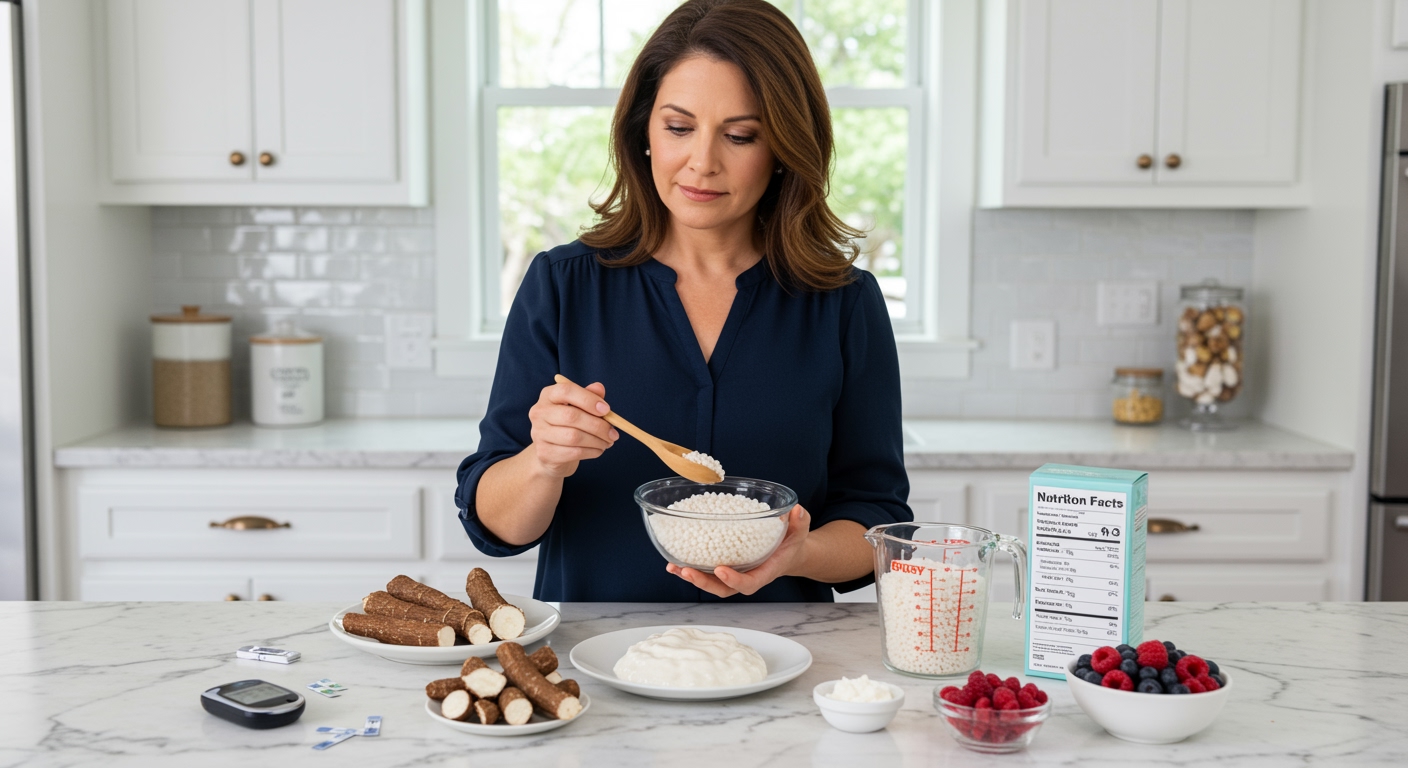✪ Key Takeaway: Sago has a high glycemic index that can spike blood sugar quickly, making it risky for diabetes management.
Introduction
Your doctor just told you that you have diabetes, and suddenly every food choice feels like walking through a minefield.
You might be wondering about sago because it seems like a simple, innocent starch that could replace rice or other grains in your diet.
Hi, I’m Abdur, your nutrition coach, and today I’m going to explain exactly how sago affects your blood sugar and whether it deserves a place in your diabetes-friendly kitchen.
What Exactly Is Sago And How Does It Affect Blood Sugar?
Sago comes from the starchy pith of tropical palm trees, primarily the sago palm.
The extraction process involves crushing the palm trunk, washing out the starch, and forming it into small white pearls that you see in stores.
When you eat sago, your digestive system breaks it down into glucose molecules that enter your bloodstream rapidly.
Research shows that sago has a glycemic index of 85, which puts it in the high category alongside white bread and instant rice.
This means that 50 grams of sago will raise your blood sugar almost as much as 50 grams of pure glucose would.
Your pancreas responds to this rapid glucose surge by releasing large amounts of insulin to bring your blood sugar back down.
✪ Fact: Sago contains almost 95% carbohydrates with virtually no protein, fiber, or healthy fats to slow digestion.
Why Do People Think Sago Is Healthy For Diabetes?
Many people believe sago is diabetes-friendly because it appears natural and unprocessed compared to refined flour products.
Traditional medicine systems often recommend sago for digestive issues, leading some to assume it must be gentle on blood sugar too.
The small pearl size and light texture create an illusion that sago is somehow lighter on your system than other starches.
Some health websites incorrectly classify sago as a complex carbohydrate when it actually behaves more like a simple sugar in your body.
The confusion also stems from sago being naturally gluten-free, which people mistakenly associate with being automatically healthier for diabetes.
Marketing messages often emphasize sago as an energy food without mentioning the rapid blood sugar spike that provides this quick energy.
✪ Pro Tip: Natural does not always mean diabetes-friendly when it comes to high-starch foods like sago.
What Happens When You Eat Sago With Diabetes?
Within 15 to 30 minutes of eating sago, your blood glucose levels begin to rise sharply as the starch converts to sugar.
If you have Type 1 diabetes, your pancreas cannot produce enough insulin to handle this glucose flood, leading to dangerous blood sugar spikes.
People with Type 2 diabetes face a double problem: their cells resist insulin action, and their pancreas may not produce enough insulin to cope with the sago-induced glucose surge.
The rapid rise in blood sugar triggers your body to release stress hormones like cortisol and adrenaline, which can make you feel jittery and anxious.
After the initial spike, your blood sugar often crashes below normal levels, leaving you feeling tired, hungry, and craving more carbohydrates.
Regular consumption of high-glycemic foods like sago contributes to insulin resistance and makes diabetes management increasingly difficult over time.
✪ Note: Blood sugar spikes from sago can persist for 2-4 hours depending on your individual insulin sensitivity.
Are There Any Safe Ways To Include Sago In A Diabetic Diet?
The honest answer is that sago offers no nutritional advantages that would justify the blood sugar risks for people with diabetes.
If you absolutely must eat sago for cultural or personal reasons, limit yourself to no more than 2 tablespoons of cooked sago per meal.
Always pair small amounts of sago with protein sources like chicken, fish, or legumes to slow down glucose absorption.
Adding healthy fats such as nuts, seeds, or avocado can help moderate the glycemic response slightly.
Never eat sago on an empty stomach, and always monitor your blood glucose levels 1-2 hours after consumption to understand your personal response.
Consider timing sago consumption around physical activity when your muscles can use the glucose more efficiently, though this strategy has limited effectiveness.
✪ Pro Tip: Test your blood sugar before and after eating sago to see your individual response pattern.
What Are Better Alternatives To Sago For Diabetes?
Instead of sago, choose cauliflower rice which provides similar texture with only 5 grams of carbs per cup compared to sago’s 35 grams.
Shirataki noodles made from konjac root contain virtually zero digestible carbohydrates and can satisfy your craving for starchy textures.
Quinoa offers a better nutritional profile with complete proteins and fiber that helps stabilize blood sugar levels.
Steel-cut oats have a lower glycemic index than sago and provide beta-glucan fiber that actually helps improve insulin sensitivity.
Legumes like lentils and chickpeas give you satisfying texture along with protein and fiber that work together to prevent blood sugar spikes.
Even small portions of brown rice or wild rice would be better choices than sago because they contain more nutrients and fiber.
The Bottom Line
Sago is not a good choice for people with diabetes because its high glycemic index causes rapid blood sugar spikes that can derail your glucose management efforts.
Your health is worth more than any single food craving, and smart substitutions can give you satisfaction without the blood sugar chaos.
I would love to hear about your experiences with managing carbohydrate choices or any questions you have about finding diabetes-friendly alternatives to your favorite foods in the comments below.
References
At NutritionCrown, we use quality and credible sources to ensure our content is accurate and trustworthy. Below are the sources referenced in creating this article:
- January AI: Sago Glycemic Index
- PMC: Nutritional and Health Aspects of Sago
- Sage Journals: Glycemic Response of Starchy Foods
- Sahyadri Hospital: Is Sago Good for Diabetes





